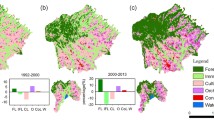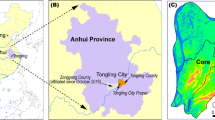Abstract
In recent years, steppe degradation in North China has become a serious environmental problem. Most research on steppe degradation is conducted at the level of communities or at the scale of small regions. To better understand the spatio-temporal variation and driving factors of grassland degradation, monitoring and analysis at broad regional scales are needed. This paper systematically describes the state and characteristics of steppe degradation at the Xilinhot plateau, makes an in-depth empirical analysis of the natural and man-made causes leading to degradation, and analyzes what driving factors have influenced degradation in this typical steppe region over the last 20 years. Ten biophysical and socio-economic variables, including altitude, slope, precipitation, temperature, soil conditions, distance to river, distance to highway, population density, sheep unit density, and fencing policy, were evaluated on their impact on observed patterns of degradation. The results indicate that all of these factors had a significant influence on the process of steppe degradation. During the first 10 years, from 1991 to 2000, steppe degradation increased, but after 2000, the degradation trend has, to some extent, reversed. The analysis indicates that the measures taken by the government, such as fencing vulnerable areas, played an important role in this change. The results advance the understanding of grassland degradation and contribute to constructing an empirical and theoretical base for grassland management and planning.









Similar content being viewed by others
References
Abel NOJ, Blaikie PM (1989) Land degradation, stocking rates and conservation policies in the communal rangelands of Botswana and Zimbabwe. Land Degrad Rehabil 1:101–123
Abulea E, Smitb GN, Snyman HA (2005) The influence of woody plants and livestock grazing on grass species composition yield and soil nutrients in the Middle Awash Valley of Ethiopia. J Arid Environ 60:343–358
Anthony DA, Roger PP, Chris DJ, Zhang YM, Lin H (2008) Livestock grazing, plateau pikas and the conservation of avian biodiversity on the Tibetan plateau. Biol Conserv 141:1972–1981
Bai WQ, Zhang YL, Xie GD, Shi ZX (2002) Analysis of formation causes of grassland degradation in Maduo county, in the source of the Yellow River. Chin J Appl Ecol 13:823–826 (In Chinese with English abstract)
Bai Y, Han X, Wu J, Chen Z, Li L (2004) Ecosystem stability and compensatory effects in the Inner Mongolia grassland. Nature 431:181–184
Bastin CN, Pickup G, Pearce G (1995) Utility of AVHRR data for land degradation assessment: a case study. Int J Remote Sens 16:651–672
Bian D, Li C, Yang XH, Bian B, Li L (2008) Analysis of the situation of grassland degradation and it’s mechanism of the Alpine Pastoral Area in Northwestern Tibet. J Nat Resour 23(2):254–261
Cao X, Gu ZH, Chen J et al (2006) Analysis of human-induced steppe degradation based on remote sensing in Xilinguole, Inner Mongolia China. J Plant Ecol (former Acta phytoecol Sinica) 30(2):268–277 (In Chinese with English abstract)
Carrion JS, Fernandez S, Jimenez-Moreno G, Fauquette S, Gil-Romera G, Gonzalez-Samperiz P, Finlayson C (2010) The historical origins of aridity and vegetation degradation in southeastern Spain. J Arid Environ 74:731–736
Chen ZZ, Jiang F (2003) Treatment on the grassland degradation. Nat Disaster Reduct China 3:45–46 (In Chinese with English abstract)
Cheng Y, Tsubo M, Ito TY, Nishihara E, Shinoda M (2011) Impact of rainfall variability and grazing pressure on plant diversity in Mongolian grasslands. J Arid Environ 75:471–476
Chomitz KM, Gray DA (1996) Roads, land use, and deforestation: a spatial model applied to Belize. World Bank Econ Rev 10:487–512
Ding WG, Lei Q, Yang Q (2007) A research on the motivation forces of the natural pasture and sustainable development in Xiahe County. J Arid Land Resour Environ 21(12):84–88
English A (2002) Coordinating the management in Xilingol biosphere reserve. In: Han NY (ed) Management of the degraded ecosystem in Xilingol biosphere reserve. Tsinghua University Press, Beijing, p 264
Evans J, Geerken R (2004) Discrimination between climate and human induced dryland degradation. J Arid Environ 57:535–554
Fu Y, Li FX, Zhang GS, Yang Q, Zeng XQ (2007) Natural grasslands degradation and environmental driving factors in Qinghai Province. J Glaciol Geocryol 29(4):525–534 (In Chinese with English abstract)
Gao QZ, Wan YF, Xu HM, Li Y et al (2009) Alpine grassland degradation index and its response to recent climate variability in Northern Tibet, China. Quat Int 4:1–8
Geerken R, Ilaiwi M (2004) Assessment of rangeland degradation and development of a strategy for rehabilitation. Remote Sens Environ 90:490–504
Geist HJ, Lambin EF (2004) Dynamic causal patterns of desertification. Bioscience 54:817–829
Gutman G (1987) The derivation of vegetation indices from AVHRR data. Int J Remote Sens 8:1235–1242
Harris RB (2010) Rangeland degradation on the Qinghai-Tibetan plateau: a review of the evidence of its magnitude and causes. J Arid Environ 74:1–12
Hijaba Y, Enkhbat B, Ulipkan B, Ronnie V, John G (2004) Reversing grassland degradation and improving herders’ livelihoods in the Altai Mountains of Mongolia. Mt Res Dev 24(2):96–100
Jiang H (2005) Grassland management and views of nature in China since 1949: regional policies and local changes in Uxin Ju, Inner Mongolia. Geoforum 36:641–653
Li B (1997) Steppe degradation in Northern China and preventing measures. Sci Agric Sinica 30(6):1–9 (In Chinese)
Li HX, Liu SZ (2007) Research on grassland degradation assessment model based on ETM+image—a case study in Naqu County of Tibet. J Soil Water Conserv 27(3):412–417 (In Chinese with English abstract)
Li XB, Shi PJ (2000) Sensitivity analysis of variation in NDVI, temperature and precipitation in typical vegetation types across China. Acta Phytoecol Sinica 24:379–382 (In Chinese with English abstract)
Li QF, Hu CY, Wang MG (2003) Analysis on the causes of eco-environmental deterioration in Xilinguole typical grassland region and counter measures. Acta Scien-tiarum Naturalium Universitatis NeiMongol 34:166–172 (In Chinese with English abstract)
Li QF, Zhao G, Zheng MG, Aminbuhe (2005) Delay grazing a practical approach to grassland environment protection and sustainable animal production in grassland of Northern China. Acta Agrestia Sinica 13(z1):45–53 (In Chinese with English abstract)
Li SY, Li XB, Fu N, Wang DD, Long HL (2007) An analysis on the degradation pattern of the steppe grassland on different slope in North China. IGARSS 2007:3433–3436
Liu ZL, Wang W, Hao DY, Liang CZ (2002) Probes on the degeneration and recovery succession mechanisms of Inner Mongolia Steppe. J Arid Land Resour Environ 26(1):84–94 (In Chinese with English abstract)
Liu LS, Zhang YL, Bai WQ et al (2006) Characteristics of grassland degradation and driving forces in the source region of the Yellow River from 1985 to 2000. J Geogr Sci 16(2):131–142
Liu JY, Xu XL, Shao QQ (2008) The spatial and temporal characteristics of grassland degradation in the three-river headwaters region in Qinghai Province. Acta Geogr Sinica 63(4):364–376 (In Chinese with English abstract)
Lu QS, Zhao ZP (2008) Eco-immigration policy for the degraded rangeland and responses of herd family in the source region of Yellow River-case study based on household investigation in Maduo County. Prog Geogr 27(3):19–28 (In Chinese with English abstract)
Ludwig JA, Bastin GN, Bastin RW et al (2000) Monitoring Australian rangeland sites using landscape function indicators and ground and remote-based techniques. Environ Monit Assess 64:167–178
Manel S, Williams HC, Ormerod SJ (2001) Evaluating presence-absence models in ecology: the need to account for prevalence. J Appl Ecol 38:921–931
Martin W, Markus S, Angelika K, Ingrid KK (2009) Degradation and small-scale spatial homogenization of topsoils in intensively-grazed steppes of Northern China. Soil Tillage Res 104:299–310
Paulo CFC, Caterina B (2009) Access to land, livestock production and ecosystem conservation in the Brazilian Campos biome: the natural grasslands dilemma. Livest Sci 120:158–162
Quinlan T (1995) Grassland degradation and livestock rearing in Lesotho. J South Afr Stud 21(3):491–508
Ringrose S, Matheson W, Tempest F et al (1990) The development and causes of range degradation features in Southeast Botswana using multi-temporal Landsat MS, imagery. Photogramm Eng Remote Sensing 56(9):1253–1262
Schleuning M, Niggemann M, Becker U, Matthies D (2009) Negative effects of habitat degradation and fragmentation on the declining grassland plant Trifolium montanum. Basic Appl Ecol 10:61–69
Shao W, Cai X (2008) Grassland degradation and its formation causes analysis in Tibetan plateau. Sci Soil Water Conserv 6(1):112–116 (In Chinese with English abstract)
Shao JA, Lu QS, Zhang XY (2008) Remote sensing-based characteristics of grassland degradation in the arid western Three-River Sources regions of Qinghai in the past 30 years. J Nat Resour 23(4):643–655 (In Chinese with English abstract)
Simon BB, Jeffrey EH, Michelle MW, Leigh M (2007) Multi-scale variability in soil aggregate stability: implications for understanding and predicting semi-arid grassland degradation. Geoderma 140:106–118
Su YZ, Li YL, Cui JY, Zhao WZ (2005) Influences of continuous grazing and livestock exclusion on soil properties in a degraded sandy grassland, Inner Mongolia, northern China. Catena 59:267–278
Swets JA (1988) Measuring the accuracy of diagnostic systems. Science 240:1285–1293
Tanser FC, Palmer AR (1999) The application of a remotely sensed diversity index to monitor degradation pattern in a semi-arid, heterogeneous, South African landscape. J Arid Environ 43:477–484
Tong C, Wu J, Yong S, Yang J, Yong W (2004) A landscape-scale assessment of steppe degradation in the Xilin River Basin, Inner Mongolia, China. J Arid Environ 59:133–149
Verburg PH, van Keulen H (1999) Exploring changes in the spatial distribution of livestock in China. Agric Syst 62(1):51–67
Verburg PH, Chen YQ, Veldkamp TA (2000) Spatial explorations of land use change and grain production in China. Agric Ecosyst Environ 82(1):333–354
Wang G, Qian J, Cheng G et al (2001) Co-environmental degradation and causal analysis in the source region of the Yellow River. Env Geol 40(7):884–890
Wu J, Loucks OL (1992) Xilingele grassland. In: US National Research Council (ed) Grasslands and grassland sciences in Northern China. National Academy Press, Washington, DC, pp 67–84
Yu L, Zhou L, Liu W, Zhou HK (2010) Using remote sensing and GIS technologies to estimate grass yield and livestock carrying capacity of Alpine grasslands in Golog Prefecture, China. Pedosphere 20(3):342–351
Yue SP, Zhang SW, Yan YC (2007) Temporal and spatial distribution of grassland degradation in Eastern Inner Mongolia: a case study in Balinyouqi. Resour Sci 29(6):156–161 (In Chinese with English abstract)
Zang SY, Na XD, Li Y, Feng ZK (2007) Driving force mechanism of grassland degradation in Daqing Region, northeastern China. J Beijing For Univ 29(Supp. 2):216–221 (In Chinese with English abstract)
Zhang YH, Hou YY, Tang SH, Lu ZG, Zhang JH (2008) Dynamic assessment of grassland degradation in Naqu of northern Tibet. Chin J Appl Ecol 19(2):278–284 (In Chinese with English abstract)
Zhao XY (2007) Human dimensions of grassland degradation: a case study in Maqu County of Gansu Province. Resour Sci 29(5):50–56 (In Chinese with English abstract)
Acknowledgments
This study was supported by National Natural Science Foundation of China (Contract No. 31060078), by National Public Welfare Project (Contract No. 200809125), by Natural Science Foundation of Inner Mongolia (Contract No. 200804040MS0514), and by Program of Higher-level Talents of Inner Mongolia University (Contract No. Z20090141).
Author information
Authors and Affiliations
Corresponding author
Rights and permissions
About this article
Cite this article
Li, S., Verburg, P.H., Lv, S. et al. Spatial analysis of the driving factors of grassland degradation under conditions of climate change and intensive use in Inner Mongolia, China. Reg Environ Change 12, 461–474 (2012). https://doi.org/10.1007/s10113-011-0264-3
Received:
Accepted:
Published:
Issue Date:
DOI: https://doi.org/10.1007/s10113-011-0264-3




